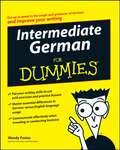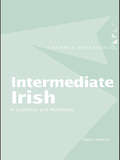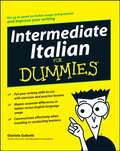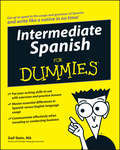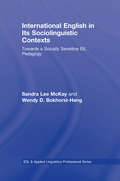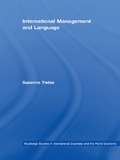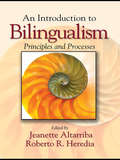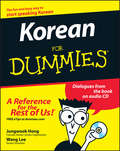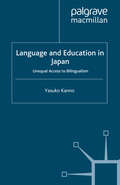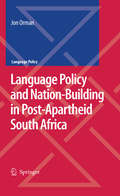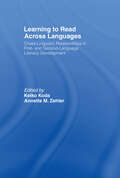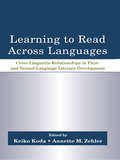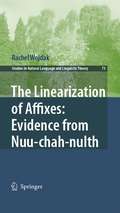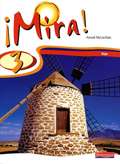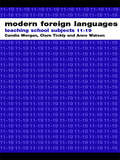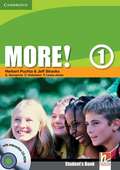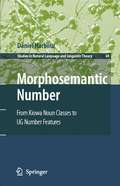- Table View
- List View
Intermediate German For Dummies
by Wendy FosterNeed to brush up on your German? Intermediate German For Dummies is your key to success in becoming confident in both written and spoken German. It gives you the straight talk and nitty-gritty detail that will see you successfully through any major or minor roadblocks to communicating in German. This friendly, hands-on workbook is loaded with practical examples and useful exercises so you can practice how native speakers use the language. From vocabulary and numbers to juggling tenses, you’ll get a clear understanding of the nuances of German style and usage that will have you writing and speaking in no time. Plus, you’ll find multiple charts that provide conjugations for all types of German verbs. You’ll get up to speed with German grammar, master essential differences between German and English language usage, and be able to communicate effectively when traveling or conducting business. Discover how to: Use fundamental German grammar, from nouns, adjectives, and adverbs to pronouns, prepositions, and conjunctions Select and conjugate German verbs correctly Understand the importance of grammatical gender in German Avoid the most common writing mistakes Use numbers and express dates and times Name countries and nationalities in German Expand your German vocabulary exponentially Get comfortable with the subjunctive Combine verbs with confidence and competence If you’re heading to any German-speaking country, sharpen your German-language skills the fun and easy way with Intermediate German For Dummies.
Intermediate Irish: A Grammar and Workbook
by Nancy StensonIntermediate Irish is a jargon-free workbook examining the most commonly used grammatical structures within the Irish language. Focusing on the repeated use of grammatical patterns, the Grammar develops an understanding of the structures presented, making the forms familiar and automatic for learners. This user-friendly workbook includes: terminology introduced and explained with multiple examples exercises in the grammatical forms introduced in the text translation exercises an exercise key.
Intermediate Irish: A Grammar and Workbook
by Nancy StensonIntermediate Irish is a jargon-free workbook examining the most commonly used grammatical structures within the Irish language. Focusing on the repeated use of grammatical patterns, the Grammar develops an understanding of the structures presented, making the forms familiar and automatic for learners. This user-friendly workbook includes: terminology introduced and explained with multiple examples exercises in the grammatical forms introduced in the text translation exercises an exercise key.
Intermediate Italian For Dummies
by Daniela GobettiTake your Italian skills to the next level the fun and easy way with Intermediate Italian For Dummies! This practical, easy-to-follow guide will help you to be more fluent and comfortable in your Italian writing. You’ll learn key concepts, practice what you’ve learned, and check your answers. With the exercises and lessons featured in this book, you will be able master written communication in Italian. You’ll quickly understand the basics of Italian grammar and pick up on the nuances of this romantic language. You’ll learn how to conjugate verbs, navigate tenses, and feel comfortable with gendered words. Say and spell words correctly, and no one will be able to tell that you’re not a native Italian. You’ll discover the basics of ordering words, answering questions, and forming complete sentences. You’ll be able to master parts of speech and apply articles as needed. Find out how to: Navigate grammar, language nuances, and verb tenses Conjugate verbs and understand the basics of gender Say and spell words correctly Order words correctly Answer questions and form complete sentences Use articles where necessary Understand the various parts of speech Write and speak Italian like a native Complete with lists of ten facts to remember about Italian grammar and ten subtle terminology distinctions, Intermediate Italian For Dummies is your one-stop guide to taking your Italian skills to the next level and improving upon what you already know about this widely spoken language.
Intermediate Spanish For Dummies
by Gail SteinNeed to brush up on your Spanish? Intermediate Spanish For Dummies is your key to success in building your writing skills and bolstering your confidence. It gives you the straight talk and nitty-gritty detail that will see you successfully through any major or minor roadblocks to communicating in Spanish. This friendly, hands-on workbook is loaded with practical examples and useful exercises so you can practice how native speakers use the language. From vocabulary and numbers to juggling tenses, you’ll get a clear understanding of the nuances of Spanish style and usage that will have you writing like a native in no time. Plus, you’ll find multiple charts that provide conjugations for all types of Spanish verbs. You’ll get up to speed with Spanish grammar, master essential differences between Spanish and English language usage, and be able to communicate effectively when traveling or conducting business. Discover how to: Use fundamental Spanish grammar, from nouns, adjectives, and adverbs to pronouns, prepositions, and conjunctions Select and conjugate Spanish verbs correctly Understand the importance of grammatical gender in Spanish Avoid the most common writing mistakes Use numbers and express dates and times Name countries and nationalities in Spanish Expand your Spanish vocabulary exponentially Get comfortable with the subjunctive Combine verbs with confidence and competence Sharpen your Spanish-language skills the fun and easy way with Intermediate Spanish For Dummies.
International English in Its Sociolinguistic Contexts: Towards a Socially Sensitive EIL Pedagogy (ESL & Applied Linguistics Professional Series)
by Sandra Lee McKay Wendy D. Bokhorst-HengPresent-day globalization, migration, and the spread of English have resulted in a great diversity of social and educational contexts in which English learning is taking place. A basic assumption of this book is that because English is an international language, effective pedagogical decisions cannot be made without giving special attention to the many varied contexts in which English is taught and learned. Its unique value is the combination of three strands – globalization, sociolinguistics, and English as an international language – in one focused volume specifically designed for language teachers, providing explicit links between sociolinguistic concepts and language pedagogy. International English in Its Sociolinguistic Contexts: fully recognizes the relationship between social context and language teaching describes the social and sociolinguistic factors that affect the teaching and learning of English examines how the social context is influential in determining which languages are promoted in schools and society and how these languages are taught is unique in directly relating basic constructs in sociolinguistics to English language teaching features case studies that illustrate the diversity of English teaching contexts Directed to a wide TESOL and applied linguistics professional readership, this text will be particularly useful and effective for pre-service and in-service professional development in TESOL for K-12 and higher education levels.
International English in Its Sociolinguistic Contexts: Towards a Socially Sensitive EIL Pedagogy (ESL & Applied Linguistics Professional Series)
by Sandra Lee McKay Wendy D. Bokhorst-HengPresent-day globalization, migration, and the spread of English have resulted in a great diversity of social and educational contexts in which English learning is taking place. A basic assumption of this book is that because English is an international language, effective pedagogical decisions cannot be made without giving special attention to the many varied contexts in which English is taught and learned. Its unique value is the combination of three strands – globalization, sociolinguistics, and English as an international language – in one focused volume specifically designed for language teachers, providing explicit links between sociolinguistic concepts and language pedagogy. International English in Its Sociolinguistic Contexts: fully recognizes the relationship between social context and language teaching describes the social and sociolinguistic factors that affect the teaching and learning of English examines how the social context is influential in determining which languages are promoted in schools and society and how these languages are taught is unique in directly relating basic constructs in sociolinguistics to English language teaching features case studies that illustrate the diversity of English teaching contexts Directed to a wide TESOL and applied linguistics professional readership, this text will be particularly useful and effective for pre-service and in-service professional development in TESOL for K-12 and higher education levels.
International Management and Language (Routledge Studies in International Business and the World Economy)
by Susanne TietzeGlobalization processes have resulted in the emergence of business and management networks in which the sharing of knowledge is of crucial importance. Combining two contemporary and important subject areas – namely that of international management and also language and communication in multi-language contexts – the author of this book presents a wealth of ideas, examples and applications taken from international and global contexts, which show that ‘language matters’ in the pursuit of international business affairs. The book establishes the theoretical core of its main ideas by introducing two orientations (social construction and linguistic relativity) and demonstrates how they can be drawn on to frame and understand the activities of managers. Highly innovative and topical, Susanne Tietze’s book will appeal to students of international management and international human resource management as well as those studying intercultural communication. It is also useful for managers and practitioners who work internationally.
International Management and Language (Routledge Studies in International Business and the World Economy #Vol. 41)
by Susanne TietzeGlobalization processes have resulted in the emergence of business and management networks in which the sharing of knowledge is of crucial importance. Combining two contemporary and important subject areas – namely that of international management and also language and communication in multi-language contexts – the author of this book presents a wealth of ideas, examples and applications taken from international and global contexts, which show that ‘language matters’ in the pursuit of international business affairs. The book establishes the theoretical core of its main ideas by introducing two orientations (social construction and linguistic relativity) and demonstrates how they can be drawn on to frame and understand the activities of managers. Highly innovative and topical, Susanne Tietze’s book will appeal to students of international management and international human resource management as well as those studying intercultural communication. It is also useful for managers and practitioners who work internationally.
An Introduction to Bilingualism: Principles and Processes
by Jeanette Altarriba Roberto R. HerediaThis important text provides a general overview of the methods and theories used in the broad domain of bilingualism. The unique interdisciplinary approach, which is reflected in the various topics covered, gives students a global picture of the field. Topics range from early childhood intellectual development to educational and social-cognitive challenges to the maturing bilingual brain. Important developing areas such as cognitive aging, creativity, the social and cultural context perspective, communication disorders and sentence processing are also covered within the volume. This text is aimed towards undergraduate courses and graduate courses in psycholinguistics, especially those with an emphasis on bilingualism or second language learning.
An Introduction to Bilingualism: Principles and Processes
by Jeanette Altarriba Roberto R. HerediaThis important text provides a general overview of the methods and theories used in the broad domain of bilingualism. The unique interdisciplinary approach, which is reflected in the various topics covered, gives students a global picture of the field. Topics range from early childhood intellectual development to educational and social-cognitive challenges to the maturing bilingual brain. Important developing areas such as cognitive aging, creativity, the social and cultural context perspective, communication disorders and sentence processing are also covered within the volume. This text is aimed towards undergraduate courses and graduate courses in psycholinguistics, especially those with an emphasis on bilingualism or second language learning.
Korean For Dummies
by Jungwook HongStart speaking Korean the fun and easy way with Korean For Dummies, a no-nonsense guide to Korean culture and the basics of Korean language. Pick up basic phrases and commonly used words so that you can converse with Koreans in both business and personal situations. You’ll learn Korean for everyday life and task-specific expressions for Korean on the go. In addition, you’ll discover important and fascinating aspects of Korean culture. This handy guide won’t burden you with lists of grammar rules; just look up the phrases and cultural phrases that you need or read through the whole book for a general overview. You’ll be able to place material in a daily context with cultural tidbits, phonetic spelling of Korean words, and the recorded Korean dialogues on the accompanying CD. Exercises will jog your memory and reinforce everything that you learn. Find out how to: Use basic phrases and words correctly Converse intelligently about Korean culture Do business with a Korean company Say task-specific expressions Pronounce Korean words Put material in a real-world context Make a good first impression with Koreans Complete with lists of ten ways to learn Korean quickly, ten phrases to make you sound Korean, ten expressions that Koreans like to use, and ten things you should never do around a Korean, Korean For Dummies is your one-stop guide to speaking basic Korean and understanding the fundamentals of Korean culture.
Korean For Dummies
by Jungwook HongStart speaking Korean the fun and easy way with Korean For Dummies, a no-nonsense guide to Korean culture and the basics of Korean language. Pick up basic phrases and commonly used words so that you can converse with Koreans in both business and personal situations. You’ll learn Korean for everyday life and task-specific expressions for Korean on the go. In addition, you’ll discover important and fascinating aspects of Korean culture. This handy guide won’t burden you with lists of grammar rules; just look up the phrases and cultural phrases that you need or read through the whole book for a general overview. You’ll be able to place material in a daily context with cultural tidbits, phonetic spelling of Korean words, and the recorded Korean dialogues on the accompanying CD. Exercises will jog your memory and reinforce everything that you learn. Find out how to: Use basic phrases and words correctly Converse intelligently about Korean culture Do business with a Korean company Say task-specific expressions Pronounce Korean words Put material in a real-world context Make a good first impression with Koreans Complete with lists of ten ways to learn Korean quickly, ten phrases to make you sound Korean, ten expressions that Koreans like to use, and ten things you should never do around a Korean, Korean For Dummies is your one-stop guide to speaking basic Korean and understanding the fundamentals of Korean culture.
Language and Education in Japan: Unequal Access to Bilingualism (Palgrave Studies in Minority Languages and Communities)
by Y. KannoThe first critical ethnography of bilingual education in Japan. Based on fieldwork at five different schools, this examines the role of schools in the unequal distribution of bilingualism as cultural capital. It argues that schooling gives children unequal access to bilingualism thus socializing them into different futures.
Language Policy and Nation-Building in Post-Apartheid South Africa (Language Policy #10)
by Jon OrmanThe preamble to the post-apartheid South African constitution states that ‘South Africa belongs to all who live in it, united in our diversity’ and promises to ‘lay the foundations for a democratic and open society in which government is based on the will of the people and every citizen is equally protected by law’ and to ‘improve the quality of life of all citizens’. This would seem to commit the South African government to, amongst other things, the implementation of policies aimed at fostering a common sense of South African national identity, at societal dev- opment and at reducing of levels of social inequality. However, in the period of more than a decade that has now elapsed since the end of apartheid, there has been widespread discontent with regard to the degree of progress made in connection with the realisation of these constitutional aspirations. The ‘limits to liberation’ in the post-apartheid era has been a theme of much recent research in the ?elds of sociology and political theory (e. g. Luckham, 1998; Robins, 2005a). Linguists have also paid considerable attention to the South African situation with the realisation that many of the factors that have prevented, and are continuing to prevent, effective progress towards the achievement of these constitutional goals are linguistic in their origin.
Learning to Read Across Languages: Cross-Linguistic Relationships in First- and Second-Language Literacy Development
by Keiko Koda Annette M. ZehlerThis book systematically examines how learning to read occurs in diverse languages, and in so doing, explores how literacy is learned in a second language by learners who have achieved at least basic reading skills in their first language. As a consequence of rapid globalization, such learners are a large and growing segment of the school population worldwide, and an increasing number of schools are challenged by learners from a wide variety of languages, and with distinct prior literacy experiences. To succeed academically these learners must develop second-language literacy skills, yet little is known about the ways in which they learn to read in their first languages, and even less about how the specific nature and level of their first-language literacy affects second-language reading development. This volume provides detailed descriptions of five typologically diverse languages and their writing systems, and offers comparisons of learning-to-read experiences in these languages. Specifically, it addresses the requisite competencies in learning to read in each of the languages, how language and writing system properties affect the way children learn to read, and the extent and ways in which literacy learning experience in one language can play a role in subsequent reading development in another. Both common and distinct aspects of literacy learning experiences across languages are identified, thus establishing a basis for determining which skills are available for transfer in second-language reading development. Learning to Read Across Languages is intended for researchers and advanced students in the areas of second-language learning, psycholinguistics, literacy, bilingualism, and cross-linguistic issues in language processing.
Learning to Read Across Languages: Cross-Linguistic Relationships in First- and Second-Language Literacy Development
by Keiko Koda Annette M. ZehlerThis book systematically examines how learning to read occurs in diverse languages, and in so doing, explores how literacy is learned in a second language by learners who have achieved at least basic reading skills in their first language. As a consequence of rapid globalization, such learners are a large and growing segment of the school population worldwide, and an increasing number of schools are challenged by learners from a wide variety of languages, and with distinct prior literacy experiences. To succeed academically these learners must develop second-language literacy skills, yet little is known about the ways in which they learn to read in their first languages, and even less about how the specific nature and level of their first-language literacy affects second-language reading development. This volume provides detailed descriptions of five typologically diverse languages and their writing systems, and offers comparisons of learning-to-read experiences in these languages. Specifically, it addresses the requisite competencies in learning to read in each of the languages, how language and writing system properties affect the way children learn to read, and the extent and ways in which literacy learning experience in one language can play a role in subsequent reading development in another. Both common and distinct aspects of literacy learning experiences across languages are identified, thus establishing a basis for determining which skills are available for transfer in second-language reading development. Learning to Read Across Languages is intended for researchers and advanced students in the areas of second-language learning, psycholinguistics, literacy, bilingualism, and cross-linguistic issues in language processing.
The Linearization of Affixes: Evidence from Nuu-chah-nulth (Studies in Natural Language and Linguistic Theory #73)
by Rachel WojdakThis book examines the problem of linearization from a new perspective: that of the linearization of affixes. The author’s driving proposition is that affixation provides a means of satisfying the universal requirement to linearize linguistic outputs. This proposition is tested using original data from Nuu-chah-nulth ("Nootka"; Wakashan family), an endangered Amerindian language that is remarkable for its complex morphology.
Mira! 3, Rojo: pupil book (1st edition)
by Anneli MclachlanMira! is a lively and comprehensive course for Key Stage 3 Spanish which puts a strong emphasis on Assessment for Learning. The course will further motivate pupils through fun ideas for starters, plenaries and thinking skills, and through its engaging software for presentation, practice and assessment. Mira! will help you to respond to the individual needs of your pupils so that they can get the most out of their Spanish lessons. Mira! 3 for Year 9 is differentiated into Rojo and Verde components to cater to pupils of all abilities. Rojo covers the Year 9 objectives of the Framework for Modern Foreign Languages. Pupils using Rojo can be assessed at National Curriculum Levels 3 to 7. In addition the course covers the QCA scheme of work.
Mira! 3, Rojo: pupil book (1st edition)
by Anneli MclachlanMira! is a lively and comprehensive course for Key Stage 3 Spanish which puts a strong emphasis on Assessment for Learning. The course will further motivate pupils through fun ideas for starters, plenaries and thinking skills, and through its engaging software for presentation, practice and assessment. Mira! will help you to respond to the individual needs of your pupils so that they can get the most out of their Spanish lessons. Mira! 3 for Year 9 is differentiated into Rojo and Verde components to cater to pupils of all abilities. Rojo covers the Year 9 objectives of the Framework for Modern Foreign Languages. Pupils using Rojo can be assessed at National Curriculum Levels 3 to 7. In addition the course covers the QCA scheme of work.
Mira! 3, Rojo: pupil book (1st edition) (PDF)
by Anneli MclachlanMira! is a lively and comprehensive course for Key Stage 3 Spanish which puts a strong emphasis on Assessment for Learning. The course will further motivate pupils through fun ideas for starters, plenaries and thinking skills, and through its engaging software for presentation, practice and assessment. Mira! will help you to respond to the individual needs of your pupils so that they can get the most out of their Spanish lessons. Mira! 3 for Year 9 is differentiated into Rojo and Verde components to cater to pupils of all abilities. Rojo covers the Year 9 objectives of the Framework for Modern Foreign Languages. Pupils using Rojo can be assessed at National Curriculum Levels 3 to 7. In addition the course covers the QCA scheme of work.
Modern Foreign Languages: Teaching School Subjects 11-19 (Teaching School Subjects 11-19)
by Norbert Pachler Michael Evans Shirley LawesCovering the training standards for NQTs and the Induction Standards and also fully exploring issues to do with subject knowledge in learning to teach, this is the essential guide for teachers of foreign languages. Acknowledging that an essential element of a secondary teacher's identity is tied up with their subject taught, the book is divided into three sections: framing the subject teaching the subject modern languages within the professional community. This book aims to provide stimulating assistance to subject specialists by helping them find ways of thinking about their specialism, how to teach with it, and how to enagage with what pupils learn through it. Written with teachers of modern foreign languages in the years of their early professional development in mind, this book is also suitable for those on PGCE courses, those in their induction year, and those in years two and three of their teaching career.
Modern Foreign Languages: Teaching School Subjects 11-19 (Teaching School Subjects 11-19)
by Norbert Pachler Michael Evans Shirley LawesCovering the training standards for NQTs and the Induction Standards and also fully exploring issues to do with subject knowledge in learning to teach, this is the essential guide for teachers of foreign languages. Acknowledging that an essential element of a secondary teacher's identity is tied up with their subject taught, the book is divided into three sections: framing the subject teaching the subject modern languages within the professional community. This book aims to provide stimulating assistance to subject specialists by helping them find ways of thinking about their specialism, how to teach with it, and how to enagage with what pupils learn through it. Written with teachers of modern foreign languages in the years of their early professional development in mind, this book is also suitable for those on PGCE courses, those in their induction year, and those in years two and three of their teaching career.
More!, Level 1 (PDF)
by Herbert PuchtaMORE! is a four-level course from a highly respected author team that's bursting with features for lower secondary students. Each level of MORE! contains 80-90 hours of class material. Key language for each unit is introduced in a photostory and put to use through the 'Language Focus'. There is thorough coverage of grammar via a dedicated secion in each unit. The 'Learn MORE through English' pages introduce cross-curricular learning (CLIL) while the 'Learn MORE about Culture' sections explore English speaking countries. Students learn to 'Read MORE for pleasure' with the extra reading pages and the CD-ROM enables students to practise vocabulary, grammar and skills.
Morphosemantic Number: From Kiowa Noun Classes to UG Number Features (Studies in Natural Language and Linguistic Theory #69)
by Daniel HarbourNumber is a major research domain in semantics, syntax and morphology. However, no current theory of number is applicable to all three fields. In this work, the author argues that a unified theory is not only possible, but necessary for the study of Universal Grammar. Through insightful analysis of unfamiliar data, the author shows that one and the same feature set is implicated in semantic and morphological number phenomena alike, with syntax acting as the conduit between the two. At the heart of the study is an original treatment of Kiowa, a North American language with a remarkable constellation of characteristics, including semantically based noun classification and complex agreement morphology. This volume presents: (1) the foundations of a unified morphosemantic theory of number; (2) insight into the flow of information from the lexicon, via syntax, into the morphology; (3) wide-ranging topics: nominal semantics, noun classes, DP syntax, agreement, suppletion, complex morphology.
